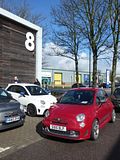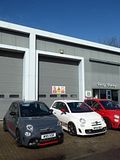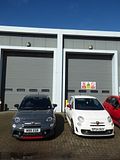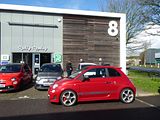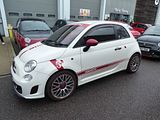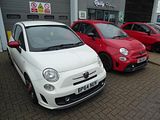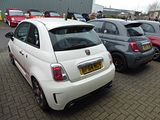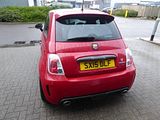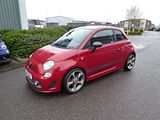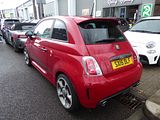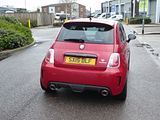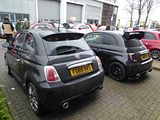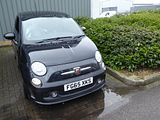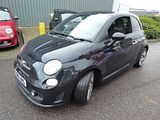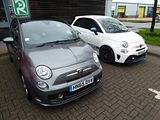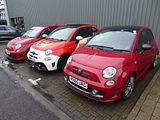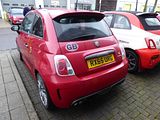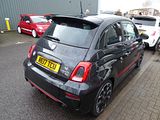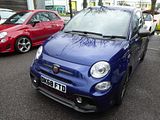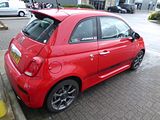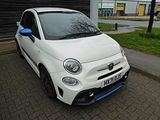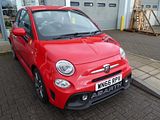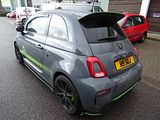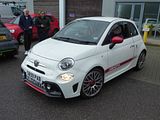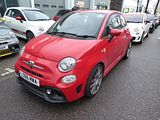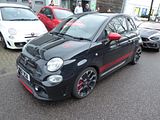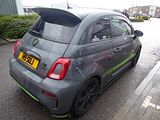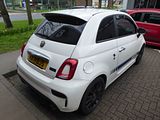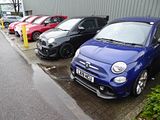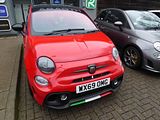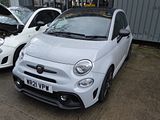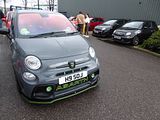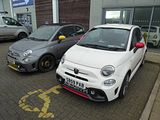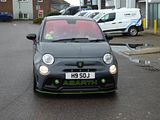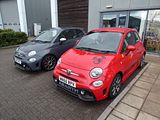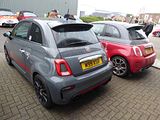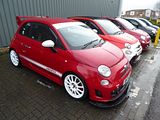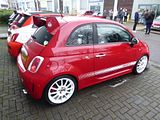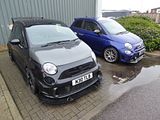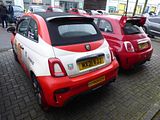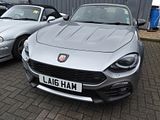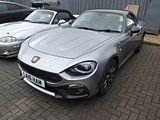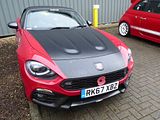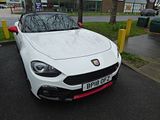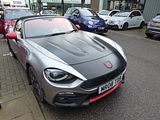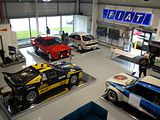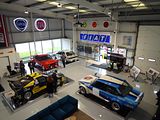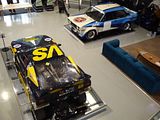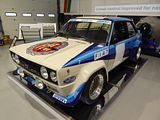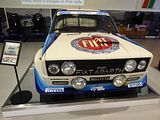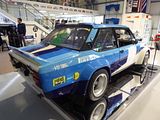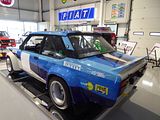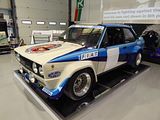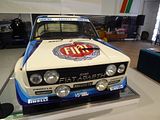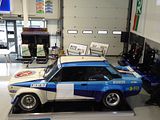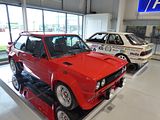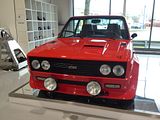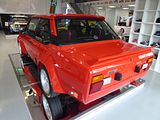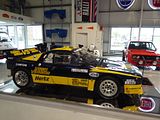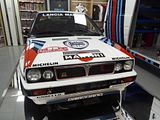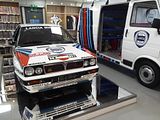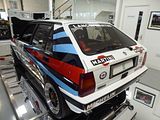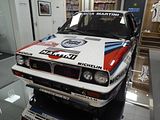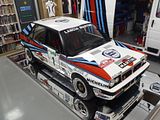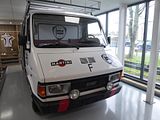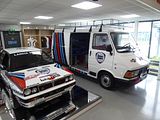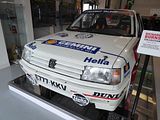When I saw details of an event that the Surrey Sussex Hampshire Abarth group were organising at a venue called Rally Replay, and the associated picture with some of my favourite ever rally cars, I just knew I had to go. Even better, the date did not clash with anything else I had in mind. I’d not heard of Rally Replay, so first of all, I had to find out where it is. The answer is Chichester, which is not exactly local to home and takes a minimum of 2.5 hours to get to. Undeterred, I inked the event onto my schedule and duly set the alarm clock for an early departure from home. It’s actually pretty easy to find, in an industrial unit just off the A27 as you pass through Chichester, though you would probably never find this place by accident as it is at one end of a lock of industrial units that is just a few yards off the main road, but access is from a couple of blocks away as the road end by Rally Replay has been blocked off to traffic. Travelling early in a morning, there was little traffic, and so it did take me around 2.5 hours to get there. Here is what I saw on arrival.
THE ABARTHS
When I arrived, there was already a good assembly of Abarth cars parked up, even though this was before the scheduled opening of Rally Replay, so there was plenty of time to see who was there, and to take Abarth photos. Whilst I was doing so, yet more arrived and space became a bit of an issue. Rally Replay only has parking for two or three cars outside their premises, but as they are at the end of a closed off road, and there are other businesses next door which were not open, we could cram cars into all available space with impunity.
The vast majority of Abarth cars here were the 500-based models which have been on sale now since the end of 2008, following a launch at the Paris Show that year. Since that time there have been a number of detailed changes to the standard cars and a lot of limited editions. Those who really know the marque can spot most of them, but some are so subtle that unless there is a badge you can see, you will not be quite sure which version you are looking at. It used to be relatively easy, when the model was first launched, as there was only one version as shipped ex works called the 500. It had a 135 bhp 1.4 litre turbo-charged engine coupled to a five speed manual gearbox, with 16″ alloys as standard, and the option of 17″ wheels, and a colour palette comprising of two whites (BossaNova White, the standard colour, or the pearlescent Funk White), Red (Pasadoble), Pale Grey (Campovolo) or Black. If you wanted more power – 160 bhp – then you could order an Esseesse kit, which came in a large wooden crate, containing new wheels, springs, an ECU upgrade, the Monza exhaust system and badging. It was dealer fitted and could be applied at any time within the first 12 months or 10,000 miles from registration. Needless to say, it proved popular. As were many of the optional extras, with stickers for the sides, a large scorpion for the bonnet and even a chequered pattern for the roof among the personalisation options offered.
Whilst a sliding glass sunroof (Skydome in Fiat/Abarth parlance) was an option from inception, fans of open air motoring had to wait until Geneva 2010 for the launch of the 500C models, with a roll-back roof which provided the best of open-topped motoring and yet still with the rigidity of the regular body style. There have been C model equivalents of all the regular production versions ever since.
For the first few months these cars only came with the robotised manual gearbox, which limited the appeal in the eyes of some, but they also introduced us to the “bi-colore”, a series of two tone cars, with upper and lower halves of the body painted in different colours. It took us a while to get used to this, as no other production road cars had been painted like this for some time, but now this is seen as yet another of those marque defining attributes, and (perhaps with the exception of the rarely seen Rally Beige and Officina Red combination that would come for 2014) in the eyes of many this distinctive look enhances the appeal of the cars still further.
Having used the legendary 695 badging from the 1960s on the Tributo cars, at the 2012 Geneva Show, Abarth dusted off the 595 name that had been used on the less powerful of the Nuova 500 based cars of the same generation, and created two new versions which we should think of as Series 2 cars, the 595 Turismo and Competizione, both of which could be bought in either closed or open top C guise, with either the 5 speed manual or robotised automated gearshifts. Both models had the 160 bhp engine as standard. Effectively they were a replacement for the Esseesse kit, and it meant that the cars were produced complete at the factory, rather than needing the dealer to undertake the upgrade (and the associated paperwork), though Abarth did not withdraw the Esseesse kits from the market for some while. Turismo, as the name suggests was aimed slightly less extreme in intent, featuring standard leather upholstery, upgraded dampers and climate control, Xenon headlights and Alutex interior details. The sportier Abarth 595 Competizione replaced the leather seats with Sabelt cloth sport seats and Alutex with aluminium, while adding p-cross-drilled brakes and the Record Monza dual-mode exhaust.
Rumours started to circulate towards the end of 2014 that Abarth were going to upgrade the Competizione model, so as better to bridge the gap between the Turismo and the 190 bhp 695 Biposto that had been added to the range earlier in the year. It was Geneva 2015 when the result was finally shown to an expectant fan base. Most exciting news was that thanks to a bigger Garrett Turbo, the engine had been tweaked to 180 bhp, and with reduced CO2 emissions. A standard spec that included Koni Dampers, Brembo brakes, Xenon lights, Sabelt seats, Climate Control, parking sensors as well as other refinements that had been added like the TFT instrument display all proved very compelling, so not long after the first cars reached the UK in June of 2015, I found temptation too hard to resist, and as is well documented here, swapped my 2010 car for one of these. At the time I ordered it, Cordolo Red, a tri-coat pearlescent paint which shimmers in bright sunlight looked set to become one of the most popular colours of the lot, even though it is a cost option. Indeed, the Launch Edition models were all offered either in this colour or Scorpion Black, with black wheels. Surprisingly, the colour was not carried over to the Series 4 cars.
What is known as the Series 4 version of the familiar 595 reached the markets in the middle of 2016. After rumours had circulated all winter following the launch of the facelifted Fiat 500 last year, Abarth finally unveiled the Series 4 at the end of May 2016. Initially, we were told that the cars would not be available in the UK until September, but that came forward somewhat, with dealers all receiving demo cars in June, and the first customers taking delivery in July. Three regular production versions of both the closed car and the open-topped C were initially available, all badged 595, and called Custom, Turismo and Competizione, as before, though numerous limited edition models have since appeared and in most case disappeared. The most significant changes with the Series 4 are visual, with a couple of new colours, including the much asked for Modena Yellow and a different red, called Abarth Red, which replaces both the non-metallic Officina and – slightly surprisingly – the tri-coat pearlescent Cordolo Red. as well as styling changes front and rear. The jury is still out on these, with many, me included, remaining to be convinced. At the front, the new air intake does apparently allow around 15 – 20 % more air in and out, which will be welcome, as these cars do generate quite a lot of heat under the bonnet. Competizione models for the UK retain the old style headlights, as they have Xenon lights as standard, whereas the Custom and Turismo cars have reshaped units. At the back, there are new light clusters and a new rear bumper and diffuser. Inside, the most notable change is the replacement of the Blue & Me system with a more modern uConnect Audio set up, which brings a new colour screen to the dash. Mechanically, there is an additional 5 bhp on the Custom (now 145) and Turismo (now 165 bhp) and the option of a Limited Slip Diff for the Competizione, which is likely to prove a popular option. Details of the interior trim have changed, with a filled-in glovebox like the US market cars have always had, and electric windows switches that are like the US ones, as well as a part Alcantara trim to the steering wheel in Competizione cars. These cars have now been on offer for five years and with Abarth sales on the rise, it was no surprise that they were particularly well represented here.
A limited edition model, the 695 XSR was created in recognition of the fact that for the third year running, in 2017 Abarth was to be the Official Sponsor and Official Car Supplier of the Yamaha Factory Racing Team, competing in the 2017 FIM MotoGP World Championship. In the wake of the Abarth 595 Yamaha Factory Racing and the 695 biposto Yamaha Factory Racing Edition, the 695 XSR Yamaha Limited Edition special series is available exclusively with a Pista Grey livery: only 695 sedans and 695 convertibles will be made. The new car was created to celebrate the Yamaha XSR900 Abarth, which is the first exclusive motorcycle to spring from the collaboration between the two brands and which sports the same grey livery with red trim as the 695 XSR, as well as sharing many of its features. The special series makes extensive use of carbon fibre to demonstrate its affinity with the front fairing, front mudguard and saddle cover of the two-wheel Yamaha. The Abarth 695 XSR and the Yamaha XSR900 Abarth also share Akrapovič ultralight exhaust developed in the racing world to boost the personality, sound and performance of both vehicles. On the Abarth car, the carbon fibre tailpipes enhance the looks and technology of the exhaust system. The XSR logo on the tailgate distinguishes the Abarth 695 XSR, while an aluminium badge identifies the sequential number of 695 units for each body type. Other carbon fibre details, in addition to the mirror caps and Akrapovič tailpipes, are available as optional equipment, such as dashboard fascia, pedal covers, gear knob and kick plate. The car uses the 1.4 T-Jet engine delivering 165 bhp. Equipment on this special series includes Koni rear suspension and Eibach springs, 17” Supersport alloy rims with Matt Black finish, Satin Chrome accents on handles and badge supports, red details on bumpers and mirrors, red brake callipers and a braking system with perforated discs. This version can be customised even further using the tuning kit to increase the power to 180 HP, improve handling by fitting a Koni front suspension with FSD (Frequency Selective Damping) valve and make braking even prompter with 305x28mm perforated and self-ventilating Brembo floating front discs with high-performance Ferodo HP 1000/1 front brake pads. It also features the new UconnectTM 7″ HD LIVE system integrated with Apple CarPlay allows iPhone users to access contents such as Apple Maps, Messages, telephone calls, Apple Music, also with Siri voice assistance.
Many owners have personalised their cars with an array of modifications, both to the way the car performs as well as the way it looks. Every one is different, and some are more distinctive than others. Many of these modified cars are very well known in the Abarth community and there were a few of the “famous” cars here, including Paul Hatton’s 500 Esseesse based car that he calls the “Imposto”, as he aimed to get close to Biposto-type capability but at a much lower cost, Tareq Beituni’s 595 packs a lot of changes under the skin as well as visually and Cathan Evans’ car has a particularly distinctive livery that seemed particularly appropriate for the theme of this event.
The Abarth 124 Spider was developed in parallel with the Fiat model. It does cost a lot more, and there are those who think you don’t get enough extra for your money, but those who have driven it will tell you otherwise. You certainly get more power. The 1.4 MultiAir turbo unit jumps up from 138bhp to 168bhp, while torque also increases by a modest 10Nm to 250Nm, which gives it a 0-62mph time of 6.8 seconds, which is half a second quicker than the 2.0-litre Mazda MX-5. The top speed is 143mph. It weighs just 1060kg meaning a power-to-weight ratio of 158bhp-per-tonne, and with the new Record Monza exhaust system it sounds great even at idle. The Abarth version gets a stiffer suspension setup than the regular Fiat 124 Spider, with Bilstein dampers and beefed-up anti-roll bars. Bigger Brembo brakes also feature, with aluminium calipers. It can be had with a six-speed manual or six-speed automatic transmission with paddles, and the latter gets a Sport mode for quicker shifts. Many of the UK cars sport the ‘Heritage Look’ pack, which is a no-cost option. It brings a matt black bonnet and bootlid, plus red exterior trim detailing and has proved popular. The £29,565 starting price gets you standard equipment such as cruise control, climate control, Bluetooth, a DAB radio and satnav, plus Alcantara black and red (or pure black) seat trim. The automatic gearbox is a £2,035 extra, while an optional visibility pack brings LED DRLs, auto lights and wipers and rear parking sensors. Sales ceased during 2019, with around 1800 cars having been brought into the UK, so this is always going to be a rare car, and values are already increasing at a rate reflecting its desirability and the difficulty in finding one.
THE RALLY REPLAY CARS and DISPLAY
10am arrived and the doors of Rally Replay were unlocked, so we could gain access to have a look. Rally Replay was due to open in the summer of 2020, with a launch planned to coincide with the nearby Goodwood Festival of Speed. But you- know-what scuppered that. In late 2021, it was finally open to the public after months of local intrigue created by its windows being covered, and the company is keen to welcome visitors. Unlike anything else in the UK, this is effectively a showroom dedicated to classic and seriously historic rally cars, some of which are for sale. But as general manager and curator Adam Midghall describes it, Rally Replay is also a “working museum” featuring an archive of mouthwatering memorabilia, including a display of items drawn from the collection of the late rally journalist, writer and competitor Martin Holmes. It’s owned by a group of private investors who have always been doing stuff in rallying behind the scenes, restoring and running cars privately, and it got to the point where they decided to make it more commercial,” says Midghall. “We want to keep the cars alive because as their values go up parts are increasingly hard to come by, people aren’t seeing the cars and younger people are not getting interested. We want to put the cars in the spotlight and create a place where people can come and see them, as a one-stop shop for rallying. It’s a new home for the sport.” The investors, who prefer to remain anonymous, clearly aim to sell cars, while Rally Replay is also an agent for Sparco race and rally gear and seat specialist Racetech. But Midghall is keen to stress a genuine altruistic motive too, promising that visitors won’t be bombarded by a hard sell. “It’s built by enthusiasts for enthusiasts,” he says. “It doesn’t matter if you’re here to just look at the cars, buy a keyring, T-shirt or sticker – it’s open for everyone. We’ll also be streaming World Rally Championship rounds live on our big screen, so you can come down to watch, and there’s no commitment to buy anything: just enjoy the space and gain a bit more knowledge about the sport. We want to get younger people more enthusiastic about rallying, because it’s not as big as it was in the past.” Among its collaborators is two-time WRC champion Miki Biasion, which partly explains the strong representation of Lancia in the displays. But as Midghall explains the cars are far from fixed. “Some of them are owned by our investors, some are owned by customers,” he says. “We have a number of customers we look after for whom we do servicing on events and preparation, and we also offer restoration services plus vehicle storage. Rally cars need looking after, so we keep them all under one roof at another facility. “Some of the cars are for sale and we are keen to promote that, but a lot of business is done online and through our contacts. It’s not something we necessarily have to push too hard here, so it’s not like a normal car showroom where as soon as you walk in you are pounced on. We’ll always have new stock rolling in and it will never be the same cars in here, to keep it fresh. The Holmes archive is central to the treasures on display and include genuine rally plates, media passes and tabards, some of Martin’s 250 trophies and even one of his old typewriters. There is also a photo archive that amounts to 20,000 images, all of which have been catalogued and are available to buy online. This is an invaluable resource for collectors, historians, publishers and journalists.
Fiat 131 Abarth Group 4: The Fiat 131 Abarth was a very successful group 4 rally car, winning the manufacturers’ World Rally Championship three times: in 1977, 1978, and in 1980. With this car Markku Alen won the 1978 FIA Cup for Drivers and Walter Röhrl won the 1980 drivers’ World Rally Championship. Between 1976 and 1981 the Fiat 131 won 20 WRC events; other notable drivers were Sandro Munari, Timo Salonen, Attilio Bettega and Michèle Mouton. Between 1975 and 1977 the official “works” cars carried the Olio Fiat blue and yellow livery, then during 1978 and 1979 seasons they were sponsored by Italian airline Alitalia and bore their distinctive red, white and green livery. The car seen here is an ex Fiat Press fleet car.
Fiat 131 Abarth Stradale: In 1976, 400 examples of the Fiat Abarth 131 Rally were built for homologation purposes. These cars were built in a co-operation between Fiat, Bertone and Abarth. Bertone took part-completed two door standard bodyshells from the production line in Mirafiori, fitted plastic mudguards front and rear, a plastic bonnet and bootlid and modified the metal structure to accept the independent rear suspension. The cars were fully painted an trimmed and then delivered back to the Fiat special Rivalta plant where they received the Abarth mechanicals. The street version of the car used a 16-valve DOHC derivative of the standard DOHC engine, which equipped with a double Weber downdraught carburettor produced 140 PS. The street cars used the standard gearbox with no synchromesh (Rally type regulations required the use of the same type of synchromesh on the competition cars as on the street versions) and the hopelessly underdimensioned brake system of the small Fiat 127. Competition cars used dry sump lubrication and eventually Kugelfischer mechanical fuel injection. In race specifications, the engine produced up to 240 PS in 1980, being driven to World Championship status by Walter Röhrl.
Lancia 037 Evo 2 Ex Fabrizio Tabaton: The design of the new Lancia Group B machine, codenamed the SE037, was approved in March 1980. The car featured a supercharged, longitudinal, four-cylinder, 16-valve engine and double wishbone suspension in the front and rear. By November 1981, the team was ready to formally announce the 037 as a project that would compete in the 1982 World Rally Championship. The team and drivers worked hard on set up and development, resulting in Lancia claiming victory in five World Rally events in 1983, en route to winning the World Rally Constructors’ Championship. The Lancia 037 was a machine built for purpose. It was designed to reign supreme over all competitors in the Group B era of World Rallying, and in 1983, it did exactly that, winning the World Rally Constructors’ Championship. The 037 also secured three consecutive European Rally Championship titles from 1983 to 1985, two Italian Championship titles in 1983 and 1985, and one Open title in 1984. Lancia continued the success it had experienced with the Fulvia, Stratos and 037, each providing valuable lessons in the design of Lancia’s future champions, the Delta S4 and Delta Integrale, which both helped Lancia cement its place as the world’s most successful WRC constructor with 10 World Championships! This car, chassis 178, was built in late 1982, being first registered to Fiat Auto Spa in Turin on 26th January 1983 and assigned the famed black-plate Italian registration ‘TO Y70772’. Having been assigned to the Jolly Club racing team, 178 was finished in white with hugely iconic green and orange stripes, as all Jolly Club cars, to mimic the Martini Racing cars which wore blue and red stripes, whilst also eluding to the near-factory level of support Jolly Club provided. In early March, this car made its competition debut at the 67th Targa Florio Rally with the soon-to-be European Rally Champion, Carlo Capone driving, Luigi Pirollo navigating, and the famed Italian racing team, Jolly Club, running the car. Round eight of the 1983 European Rally Championship, the Targa Florio Rally, saw 64 starters, but only 34 finishers, with the Lancia 037 Rally dominating. Of the four 037’s entered, three finished, taking first, second and third overall! Chassis 178 with Capone and Pirollo finished a remarkable second overall, being only narrowly beaten by the sister 037 of Franco Cunico. Three weeks later, 178 was shipped to the second-largest island in the Mediterranean, Sardinia, for the 6th Rally Costa Smeralda. The gravel event was held around the famed billionaires playground of Porto Cervo, attracting in excess of 100 entrants, 9 being Lancia 037’s! As the flag fell at the end of round ten of the 1983 European Rally Championship, Carlo Capone had again driven 178 very well, finishing fourth overall. The next event for this car was the 1983 Rally Internazionale della Lana, round 21 of the European Rally Championship, again being piloted by Carlo Capone and assigned race number 7. The 11th running of the asphalt event saw it based in the Biella region, covering over 500 kilometres. Capone was once again driving impeccably, taking a commanding victory over the sister Jolly Club 037 driven by Miki Biasion. After its dominant victory in its most recent event, chassis 178 next competed in round 9 of the 1983 World Rally Championship, Rally Sanremo, being entered by the Tre Gazzelle team. At the tender age of 22, Andrea Zanussi was making his World Rally debut, after several successful years with the Fiat 131 Abarth and 037 Rally in the European Rally Championship. With a new driver, came new sponsors for 178 which was no longer wearing Jolly Club stripes, instead white and red sponsorship of the German cigarette brand, R6. The 1983 Sanremo WRC event was always going to be an uphill battle for the new kid on the block, Zanussi, however he still impressed with several fourth and fifth place stage finishes, even more so considering there were eight Lancia 037 Rally’s entered! Unfortunately, Andrea Zanussi and Sergio Cresta suffered an accident, and despite making it to the end of the stage, chose to retire after stage 33. This was also the event at which Lancia and the 037 claimed victory in the World Rally Championship! The final rear wheel drive car to ever win the WRC Championship! In March 1984, chassis 178 was sold to HF Grifone and re-registered in Italy on license ‘GE 941679’ and refinished in the famous blue and yellow livery with Olio Fiat sponsorship. This car made its return to Sanremo for the 1984 World Rally Championship event, this time being driven by Fabrizio Tabaton and Luciano Tedeschini. Tabaton was to become a double European Rally Champion, having begun his rallying career in 1970 with a Fulvia, before moving on to a Stratos in 1976, and a works Martini Racing 037 in 1982 before claiming the 1985 Italian Rally Championship aboard an 037. For 1986 he moved up to the Delta S4, claiming the European Rally Championship, which he won again in 1988 with a Delta Integrale! At the Sanremo rally in 1984, driving this 037, Fabrizio Tabaton claimed his highest World Rally Championship finish, fourth overall, behind only the four-wheel drive Peugeot 205 Turbo 16 of Ari Vatanen, and the 037’s of Attilio Bettega and Miki Biasion, an impressive result for the 19-year-old! In 1985, chassis 178 was used regularly by Massimo Lugli, who had previously competed with a Lancia Stratos. Lugli competed in four rounds of the Italian championship and in 1986 finished second overall at the Tirrenia Rally, and Rally Dell’Emilia – Coppa Citta di Modena, partnered by Enrico Santini at both events. April 1987 saw this 037 being bought by Raceprogram di Giovanni Claudio in Castellarano, Italy. 178’s final period rally was the 1987 Rally del Sestriere where it was driven by Luca and Rita Borghi, finishing 3rd overall wearing race number 19. Famed rally car preparer Angelo Chiapparini bought this car in August 1990. At the time of his passing, Chiapparini owned this car and passed it to his wife, Gianna Luigia Croce, from whom the previous owner purchased it in 2004, before registering in the car in Monaco with the license ‘X 037’. Throughout the previous owner’s custody, this car was returned to Turin where it was inspected and maintained by the famed Baldi twins, Elio and Giovanni. These brothers are ex-works mechanics who worked on the cars in period in both the test department, and at rally events around the world. There simply can be no better team to maintain your competition Lancia rally car, than the mechanics who ran them in period. Having purchased the car, we have returned the car to Turin where it was again inspected and mechanically rebuilt by these famed brothers, ensuring it is in the optimum condition.
: In 2018, Double World Rally Champion Miki Biasion set out to build a one-off car to celebrate his first World Rally Championship back in 1988. Biasion’s success came with Lancia in partnership with fellow Turin based drinks manufacturer Martini, whose colours dominated the design of the Delta Integrale. Having won Four of the Six rounds before the Sanremo Rallye, Miki and Co-Driver Tiziano Siviero were in for a shot at lifting the drivers championship on their home round. Lancia would field six cars for the event, where the attention would also turn to securing the manufacturers title for the second year running. Biasion would go on to win the Sanremo, winning sixteen stages over the course of the rally. A very important victory for the Italian team, drivers and sponsors on their home event, not only would it secure their first Drivers Championship, but also the manufacturers title. There is no championship like your first, which is why Biasion set out to commemorate his achievements of the 1988 season with this very car, a one off. After sourcing a suitable donor car, Biasion handed the car over to his team to completely restore the car, starting with the bare bodyshell. Finished in the colours of the Sanremo Rallye, the Martini stripes were painted onto the car just like the Factory Rally Cars in period. A custom set of Speedline “Abarth tarmac” three piece split rims were produced exclusively for the car in order to replicate the wheels used by the Factory team, but modified for road use. A number of other Group A inspired items include Carbon Kevlar bucket seats with Martini covers to mimic those fitted in the Factory cars from 1988, Vitaloni Californian Mirrors, Group A front indicators and tow hooks, and a front lip designed off the back of the factory sump guards. Mechanical changes were made with Bilstein adjustable suspension and a bespoke exhaust system with the tips engraved with Biasion’s signature. Completing the car are the Mondiale ‘88 badges and Biasion’s signature steering wheel. The car’s debut came at the Padova Auto e Epoca in late October 2018, where both Biasion and Siviero launched the car to the public eye. The famous Italian event saw over one hundred thousand visitors over four days.
This is a faithful replica of an Iveco Daily Lancia Service Van: One of the first vehicles born from the company founded in 1975 by Fiat Veicoli Industriali, Lancia, Magiruz-Deutz, OM and Unic was a 3.5t van / truck with chassis, heir to the Fiat 615-616 and 625 and the OM Orsetto. Modern in design and very robust, the Fiat Daily has had a very long career and is now in its fifth generation. The first remained on the list from 1978 to 1990, with a 2445cc and 80hp diesel (model 35.8), flanked after 1985 by a 100hp turbo (35.10). It was initially also available as Fiat / Unic / Magirus Daily and as OM Grinta, all of which were later replaced by the Iveco brand.
Ex Richard Burns 1988 Peugeot 309 GTI Group A: Built in early 1988 by Peugeot Talbot Sport UK to Group A specification, E777 KKV was first registered on the 17th february 1988 and was immediately allocated to super suede Kalle Grundel for that year’s British Rally Championship. The cars first outing would be at the Cartel International Rally but it would be short lived with Grundel suffering with a loss of oil which would force him out of the event. Grundel would go on to compete on the Circuit of Ireland, Welsh and Ulster before handing over to Mikael Sundström to contest the Manx. The year would be rounded out with Grundel getting back in the car for the RAC to finish a fine 10th place overall and second in class. For 1989, E777 KKV would be allocated to young Swede Håkan Eriksson, the younger brother of Kenneth. Eriksson would contest the whole of the 1989 British Rally Championship for his first championship outside of Sweden. Eriksson would return in 1990 for another season in the British Rally Championship with the Peugeot Talbot Sport Team. As was now becoming a tradition, the season would start on the Cartel Rally. With an upgraded Group A specification over last year’s car, Eriksson by his own admission just wasn’t getting to grips with the car and therefore the times were not coming on the first half of the rally. With some setup adjustments in service, Eriksson came through the field strongly to take the class win and 7th overall. A class win would follow on the Circuit of Ireland after finishing 8th overall, the only hiccup being a loose gear linkage. Eriksson commented “perhaps we have two more days of rally, then we will win”, clearly the confidence in the car was high! Onto the Welsh International, the winning spree would continue in the unusually hot and dry stages. Despite Eriksson having to have the interior fan on to cool the engine, they finished a remarkable 4th overall and 1st in class. The Scottish would bring a further class victory and 8th overall, only scuppered by collecting a number of punctures. However this would be enough for Eriksson to lift their class title. In return for winning the 1991 Peugeot Cup, Richard Burns would be given a prize drive in E777 KKV on that year’s RAC Rally. Peugeot’s Des O’Dell was hoping to find the next British driver to go on and be World Champion and by providing a car for the RAC for Burns proved to be a step in the right direction. With the first day’s stages being held on mainly stately home grounds, the little Peugeot would come out fighting with a number of top 30 stage times leaving Burns and Reid in 30th overall. As the fog and rain came into Wales for the second day’s stages, the 309 used its lightweight and nimble character with Burns at the wheel to its advantage. After completing the forests of Clocaenog and Hafren there would only be one two wheel drive car ahead, that being the Works Vauxhall of Dave Metcalfe. As the rally headed north towards Kielder Forest, the pace would only improve. Rarely would Burns be seen setting times that weren’t fastest in his class. As the weather started to improve, so did the move up the leaderboard. Entering the last day of the rally, Burns would be up to 17th position overall with only four stages until the end of the 565 kilometre event. Richard Burns and Robert Reid led their class from the finish of SS7 right through to the end of the rally, some 30 stages later. 16th Overall and 1st in Class would bring E777 KKV across the finish line after four days of competition. A dominant performance for the 20 year old youngster behind the wheel and showing great promise for the future. Following the RAC, the car would be retained by Peugeot and would eventually be sold to Ian Patterson in May of 1998. Patterson would contest that year’s Scottish Rally before the car would be sold to none other than Richard Burns through Steve Black of SBG Sport in April of 1999. The decision would be made to fully restore the car to as it was on the 1991 RAC which included the engine and gearbox being fully rebuilt by Davison Motorsport. The car was completed in February of 2000 where it then joined Burns’s personal collection of cars he had campaigned over his career to date. Autosportif Engineering were tasked with maintaining the complete collection for Burns. Sadly Richard Burns would pass away in 2005 following a lengthy illness, he remains the only Englishman to lift the World Rally Championship Title. Throughout his career, Burns claimed the 2001 World Drivers Championship, 10 World Rally Victories, 1 British Rally Championship, 2 Peugeot Cup Championships and a Sole British National Championship. Following his death the car remained in the care of Richard’s family who used the car to promote the newly founded Richard Burns Foundation, a charity set up to help people and families with cancer and neurological illness. The car remained in the care of Autosportif Engineering who maintained the car ready for shows across the UK such as the Goodwood Festival of Speed, Wales Rally GB and the Autosport Show. E777 KKV entered private ownership in August of 2021 and was once again sent to Autosportif to be overhauled ready for that year’s Rallyday show at Castle Combe where the 20th anniversary of Burns World Championship would be celebrated.
No question, it was well worth that early morning alarm and the 130 mile drive each way. Rally Replay is a delightful place, well worth a visit from anyone who has an interest in rallying heritage. Whilst the premises are relatively small, there is much in here to charm and interest and we are promised that the content will continually change as cars are sold and yet more artefacts are acquired. Add in a meet with one of the friendliest of all the Abarth Groups and this really was a great day.


